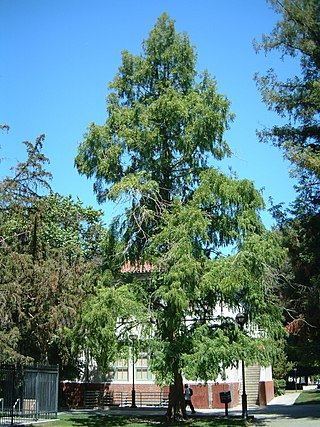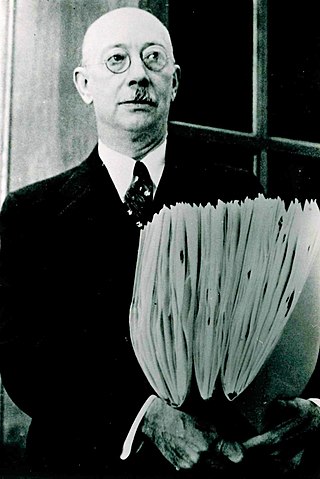
Metasequoia glyptostroboides, the dawn redwood, is a fast-growing, endangered deciduous conifer. It is the sole living species of the genus Metasequoia, one of three genera in the subfamily Sequoioideae of the family Cupressaceae. It now survives in the wild only in wet lower slopes and montane river and stream valleys in the border region of Hubei and Hunan provinces and Chongqing municipality in south-central China, notably in Lichuan county in Hubei. Although the shortest of the redwoods, it can grow to 167 ft (51 m) in height.

The Arnold Arboretum of Harvard University is a botanical research institution and free public park, located in the Jamaica Plain and Roslindale neighborhoods of Boston, Massachusetts. Established in 1872, it is the oldest public arboretum in North America. The landscape was designed by Charles Sprague Sargent and Frederick Law Olmsted and is the second largest "link" in the Emerald Necklace. The Arnold Arboretum's collection of temperate trees, shrubs, and vines has an emphasis on the plants of the eastern United States and eastern Asia, where arboretum staff and colleagues are sourcing new material on plant collecting expeditions. The arboretum supports research in its landscape and in its Weld Hill Research Building.

Henry Allan Gleason (1882–1975) was an American ecologist, botanist, and taxonomist. He was known for his endorsement of the individualistic or open community concept of ecological succession, and his opposition to Frederic Clements's concept of the climax state of an ecosystem. His ideas were largely dismissed during his working life, leading him to move into plant taxonomy, but found favour late in the twentieth century.

Alfred Rehder was a German-American botanical taxonomist and dendrologist who worked at the Arnold Arboretum of Harvard University. He is generally regarded as the foremost dendrologist of his generation.

Elmer Drew Merrill was an American botanist and taxonomist. He spent more than twenty years in the Philippines where he became a recognized authority on the flora of the Asia-Pacific region. Through the course of his career he authored nearly 500 publications, described approximately 3,000 new plant species, and amassed over one million herbarium specimens. In addition to his scientific work he was an accomplished administrator, college dean, university professor and editor of scientific journals.

Oakes Ames was an American biologist specializing in orchids. His estate is now the Borderland State Park in Massachusetts. He was the son of Governor of Massachusetts Oliver Ames and grandson of Congressman Oakes Ames.
Johannes Conrad Schauer was a botanist interested in spermatophytes. He was born in Frankfurt am Main and attended the gymnasium of Mainz from 1825 to 1837. For the next three years he worked at the Hofgarten of Würzburg. Schauer then gained a position as assistant at the botanical garden at Bonn where he worked until 1832 when he was placed in charge of the botanic garden in Breslau, with C.G. Nees. He gained the degree of Doctor of Philosophy at the University of Erlangen-Nuremberg 1835 and was appointed professor of botany at the University of Greifswald from 1843 until his death in 1848.
Peter Shaw Ashton is a British botanist. He is Charles Bullard Professor of Forestry at Harvard University, and director of the Arnold Arboretum there from 1978 to 1987.

John Whittle Terborgh is a James B. Duke Professor of Environmental Science at Duke University and co-director of the Center for Tropical Conservation. He is a member of the National Academy of Sciences, and for the past thirty-five years, has been actively involved in tropical ecology and conservation issues. An authority on avian and mammalian ecology in Neotropical forests, Terborgh has published numerous articles and books on conservation themes. Since 1973, he has operated the Cocha Cashu Biological Station, a tropical ecology research station in Manú National Park, Peru.
George Neville Jones, usually known as G. Neville Jones, (1903–1970) was an English-born botanist who spent most of his life and career in the United States. He was a professor of botany at the University of Illinois (Urbana) at the time of his death.
Irving Widmer Bailey was an American botanist known for his work in plant anatomy.
Lily May Perry (1895-1992) was a Canadian-American botanist who worked at Arnold Arboretum and is most known for detailed compilation of information on medicinal plants of East and Southeast Asia and her assistance with the Flora of New Guinea. Perry also has the legacy of authoring the third highest number of land plant species among female scientists, in total naming 414 species.
Joseph Edward Laferrière is an American botanist with a particular interest in ethnobotany.
Michael Donoghue is an American evolutionary biologist, currently the Sterling Professor of Ecology and Evolutionary Biology at Yale University, and also a published author.
Yevgeniya Nikolayevna Sinskaya (1889-1965) was a Russian botanist noted for her research in plant taxonomy, phytogeography, species formation, and genetics. She was head of the Taxonomy, Ecology and Geography Division at the Institute of Plant Industry. The standard author abbreviation Sinskaya is used to indicate this person as the author when citing a botanical name.
Ida Panovna Mandenova was a Soviet/Georgian botanist and taxonomist noted for studying and describing Heracleum. She described at least 90 plants. The standard author abbreviation Manden. is used to indicate this person as the author when citing a botanical name.
Marie Laure Tardieu-Blot was a French pteridologist who worked at the National Museum of Natural History (France) and is noted for describing over 400 species. The genus of ferns Blotiella was named in her honor. She was married to the author Jean Tardieu. The standard author abbreviation Tardieu is used to indicate this person as the author when citing a botanical name. She was appointed director of the medical analysis laboratory of the Hanoi hospital in 1928. She joined the phanerogamy laboratory of the National Museum of Natural History in 1932, the same year she became a member of the Botanical Society of France. She was appointed deputy director of the Muséum national d'histoire naturelle in 1964. She became director of the laboratory of tropical phanerogamic botany in 1967. She was finally named honorary director in 1971.
Barbara Ann Whitlock is a botanist, who earned a Ph.D. from Harvard University, with her dissertation Systematics and evolution of chocolate and its relatives c. 2000, an interest which continues.

Emma Jane Cole was an American teacher, botanist, and curator, and the author of Grand Rapids Flora: A Catalogue of the Flowering Plants and Ferns Growing Without Cultivation in the Vicinity of Grand Rapids, Michigan. She was inducted into the Michigan Women's Hall of Fame in 2007.
Charles Jeffrey was a British botanist.







